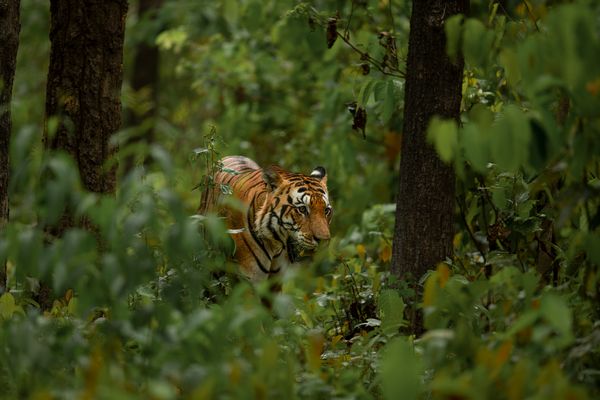Tiger facts & Myths
1. Wild tigers may be found in Africa. Tigers are native to Asia, where they are presently found in 14 countries called the “tiger range states.” Lions are now found almost solely in Africa; there is only one relict population in India, located in the Gir National Park and Lion Sanctuary in Gujarat.
2. Tigers, like most cats, dislike water and carefully avoid it. Actually, tigers take readily to water and are excellent swimmers, as is shown by the tigers of the Sunderbans, a vast area of mangrove swamps straddling the Indian border with Bangladesh. Tigers need to drink regularly, and they often slip into pools of water (hindquarters first) to cool off in the hot weather.
3. Today’s tigers are descendants of the prehistoric sabretooth tigers. This is false. The sabre-tooth tiger (Smilodon) species that we know from fossil remains like those at the La Brea tar pits in southern California are not even close relatives of the modem tiger.
4. Tigers will attack human beings every time they get a chance. False. Tigers normally go out of their way to avoid human contact.
5. Tigers roar when they attacktheir prey. The tiger does not need to draw any more attention to its approach than is already the case in the Indian jungle, with many animals and birds issuing alarm calls that publicize the big eat’s movements. Almost invariably, tigers are silent when they approach and attack their prey.
6. Tigers prefer small prey to large prey. If given a choice, tigers (like African lions) will go for large prey, since killing a ”big-ticket item” is more energy-efficient.
7. White tigers are albinos. False. The colour of white tigers is due to a recessive gene. Unlike true albinos, white tigers have blue (rather than pink) eyes.
8. All tigers are roughly the same size, with the exception that males are somewhat larger than females. Depending on the subspecies and the habitat, tigers vary dramatically in size and weight. A Siberian male tiger, for example, may be four times heavier than a Sumatran female.
9. The basic social unit in tigerland is a mating pair. No: the basic social unit of this typically solitary species of big cat is a mother with her offspring.
10. Tiger hunts have a high success rate. The reputation of the tiger as a “killing machine” is greatly exaggerated. Only one in 10-20 tiger hunts is successful.
11. Tigers are good tree climbers. There are some famous treeclimbing African lions, notably in Lake Manyara National Park in Tanzania. Tigers, however, are not normally tree climbers, being too heavy. Tribals escape a charging tiger by climbing a tree, and for centuries hunters in India used to employ machans, or watch platforms in trees, to ambush tigers.
12. A male tiger’s territory measures about the same as a female’s. Typically, the territory of a male tiger is several times larger than that of a female. The reason seems to be that the primary cause of territoriality in males is not access to food, but rather access to females for breeding.
13. Winter is the mating season for tigers. This is an old dictum about tigers that one may see repeated in the shikari literature. However, while winter may be preferred in certain habitats, tigers in India may be conceived and born throughout the year.
14. Every individual tiger can be identified by its pug marks, which are like fingerprints. The battle over this one never ends. Suffice it to say that four eminent tiger authoritiesGeorge Schaller, Pateh Singh Rathore, Ullas Karanth and Billy Arjan Singh-are on record as puncturing the balloon of this myth. The best that can be hoped for (with practice and careful observation) is that pug marks may enable you to tell a female from a male, to verify the presence of cubs, or to learn of an unusual physical characteristic or an injury.
15. Tigers never move around during the day. Never say “never.” Depending on temperature conditions, prey movements, and other factors, it is possible to see tigers moving in mid-morning and mid-afternoon, although sightings are generally unlikely during the middle of the day, when tigers prefer to rest.

ENQUIRE NOW
Lets plan your safari tour. Please fill the enquiry form below and our team will get back to you within 24 hours with a perfect safari package.






